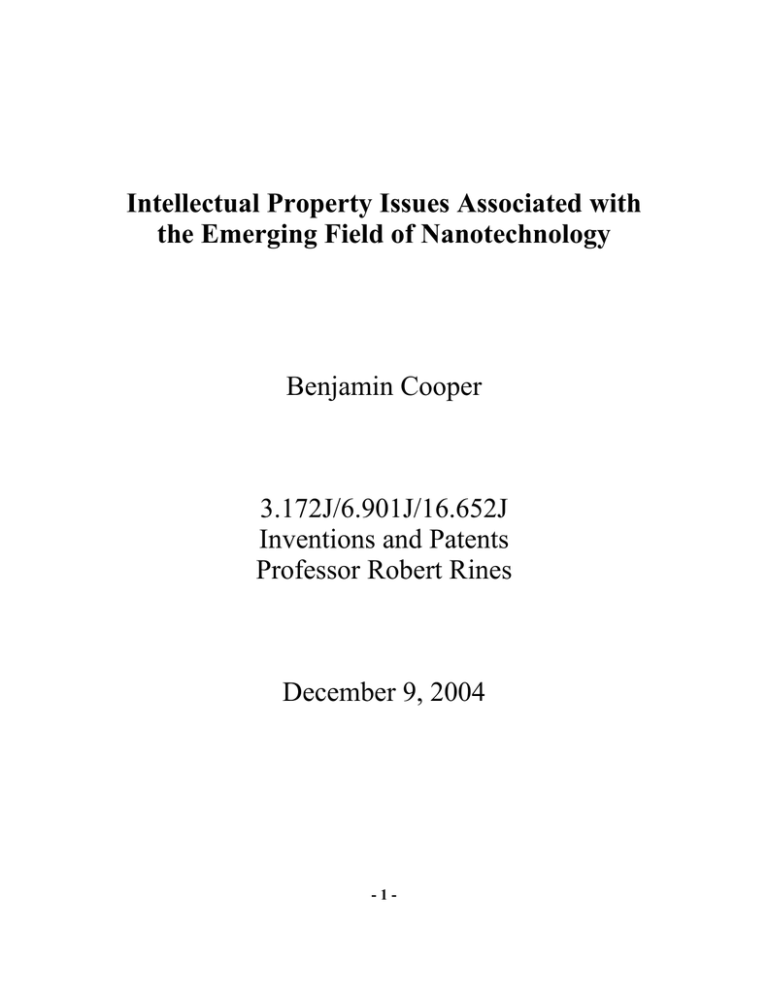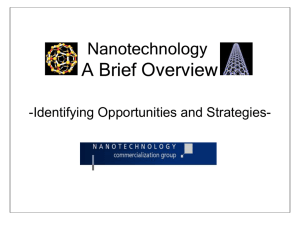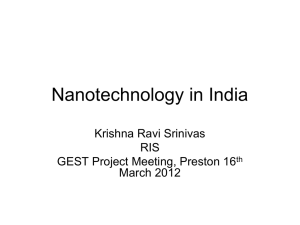Intellectual Property Issues Associated with the Emerging Field of Nanotechnology Benjamin Cooper 3.172J/6.901J/16.652J
advertisement

Intellectual Property Issues Associated with the Emerging Field of Nanotechnology Benjamin Cooper 3.172J/6.901J/16.652J Inventions and Patents Professor Robert Rines December 9, 2004 -1- In the last few years, nanotechnology has strongly emerged as an academic and commercial force. Nanotechnology is the practice of engineering materials on scale of a billionth of a meter using “bottom-up” approaches that involve molecular control over the product. Scientific breakthroughs in processing inorganic and biological materials at these very small scales has generated much excitement about the possibilities and applications of molecularly constructed designs. The National Nanotechnology Initiative (NNI), established by legislation during the Clinton administration in 1999, has targeted the field with billions of dollars for scientific research projects and catalyzed the expansion of nanotech. Although all forms of technology are subsumed with the constitutional protection of intellectual property, the issues facing inventors are uniquely manifested by the history and character of the nanotech field. The act of patenting nanotechnology has been fundamentally affected by its intimate association with universities and government funding, incipient state, and interdisciplinary nature. Many inventors at the research level find themselves forced to limit their rights to own patents by their dependence on large, overbearing institutions, which does not provide the necessary incentive to promote invention and advancement of the useful arts. Organization of the academic research community to understand their power to renegotiate university dominance over patent ownership can improve the stimulation to invent, as well as a systematic technique of improved revenue apportionment for spin-off companies. The contemporary problem of backlog in the United States Patent and Trademark Office (USPTO) because of the diverting of application funds by Congress has also been a severe impediment to the emergence of nanotechnology that did not exist for previous technologies to overcome. -2- Since nanotechnology involves fabricating components from the atomic level, there are numerous overhead deterrents to the individual, small inventor. While several schemes exist for relatively cheap and easy manufacture of nanotech devices, the subsequent molecular scale analysis requires extremely expensive equipment that is unavailable to independent inventors. Universities and government research laboratories typically have entire facilities dedicated to nanometer resolution instruments (scanning electron microscopy, tunneling electron microscopy, atomic force microscopy, etc.) that are run by specifically trained employees who only deal with performing and training students in these forms of microscopic analysis. The writing of software algorithms and code, assembly of electrical circuits into operational devices, design of mechanical systems, and chemical processing require significantly less resource management. While these fields are at the very least visible to the human eye or can be investigated by macroscopic experiments, nanotechnology (which occurs at ranges below the wavelengths of visible light) is hindered by a reliance on nanoscale instrumentation, which pushes research into universities and government, instead of free-enterprise companies or independent ventures that cannot meet the financial overhead for invention. The tendency of existing companies to frequently strip their employees of intellectual property ownership also has propelled nanotech into academic institutions. For most of the history of the patent system, universities allowed professors and researchers to maintain the rights to their inventions. However, in the past decades or so, there has been a sharp trend towards universities “sharing” in the ownership of revenues from patents filed under their authority, meaning they take partial ownership with the inventor. At MIT, professors assign half the revenue of each patent to the university. -3- Merely by occurring later, the development of nanotechnology at universities has maintained less rights to the inventor than other technologies have had to face. Universities claim that they are encouraging innovation by sharing revenue, which corporations do not, but they are really taking advantage of the modern atmosphere where individuals rarely are allowed to work on a project and keep the intellectual property rights of their work. The rights of professors and research associates at universities could be greatly protected by forming a watchdog organization for that purpose. The “unionlike” body would educate professors, (who are extremely bright and focused on scientific matters, but are frequently unfamiliar with intellectual property law), as long as they are not hired to invent a specific contrivance, that they have original ownership of their invention, even including when common use of university facilities was made. The judicial system appears to have become more sympathetic to professors and researchers' patent rights by ruling against the practice of using an invention in a research context and awarding infringement decisions (most notably a case with Duke University which continued research after an assigned inventor professor left). Unfortunately, most professors sign away their patent rights when joining the faculty, so the organization would also heavily emphasize renegotiation of contractually assigned patents. Although, this problem of little incentive to not only innovate, but also commercialize and market when half the money goes to the university applies to all technologies, nanotech research can only survive at academic institutions, so the concept becomes exaggerated. Spin-off companies, out of university laboratories, have become a widely used model where commercialization and product development are actually important. These companies are the most important aspect to the future of nanotech because they will drive -4- the economy towards accepting the technology and also the world will reap the benefit of products that are greatly improved through nanotechnology. The university-to-business approach has not yet reaped actual nanotech products, underlying the generally academic attitude that has prevailed due to lack of incentive from forfeit of patent rights. Although large companies generally maintain all intellectual property rights, the first nanotech products to hit the market have actually come established corporations such as Dupont, Kodak, L'Oreal, along with Nano-tex (stain/water resistant pants) and Quantum Dot Corporation. Industry's massive financial backing is largely responsible for these advancements, where there is little or no expectation for keeping patent rights, unlike the pioneering appearance of academia that is betrayed by its growing disregard for inventor's rights. In fact, most of the nanotechnology applications by corporations are targeting towards improvement on the function of an existing product and maintaining market share, but not genuine, groundbreaking innovation. Brighter LEDs, improved biological imaging, higher performance cosmetics, and hydrophobic coatings on clothing (from companies above) are just that- upgrades to what is currently used, but not ubiquitous or revolutionary (such as the creation of displays, computing, internet media, and automation associated with the digital electronics technology). The disruptive technologies of nanotech will only come from small start-ups looking to break into the market, which the academic system does not do a good enough job of stimulating. Furthermore, several university research spin-off companies have specifically chosen not to deal with products, since they won't get much of the revenue anyway, and merely develop technology to license it. The practice has become all too common to develop -5- multiple ways of inventing a novel nanotechnology, then sit on the right to exclude others from making or using the invention unless they pay to license it. Such behavior clearly retards the impact of nanotech by maintaining a conservative, defensive approach. For example, Carbon Nanotechnologies Incorporated, started by Richard Smalley of Rice University, a Nobel prize winner for his work on the synthesis of carbon nanotubes and carbon fullerenes (widely considered some of the most promising nanomaterials), is an intellectual property portfolio company that has no intention of fabricating or marketing products, just licensing. Mainstream culture will not derive the benefit from products of many nanotechnologies simply because the university system has greatly hindered the ability to turn a patent to personal profit. Nanotechnology, because it is only defined by a length scale and a bottom-up approach, has also moved towards becoming extremely interdisciplinary. Cells and medically important biological systems are nanometer-sized, and have thus generated much interest in interfacing multiple studies (electrical engineering, materials science, and biomedical engineering). This aspect is actually well-approached by the academic system, where all studies take place at a university and professors have easy access to experts in different departments. However, issues of ownership arise from sharing multiple pieces of the patented invention. It has become widespread for graduate students or researchers to feel they should be given credit as an assigned inventor on a patent, and this is amplified when multiple laboratories are collaborating on a nanotechnology project. Who conceived the idea and what are the vital components that determine who gets credit? The answer is not always so obvious when you are, say, using DNA and antibodies to self-assemble carbon nanotubes into a computational -6- circuit. This creates problems for the USPTO when examiners have to understand an interdisciplinary invention and classify it to simplify the literature and searching mechanism. In fact, the USPTO just established a new cross-reference digest (Class 977/Dig.1) to improve the ability to search and examine nanotech patents as of October 18, 2004. This directive provides for patents “related to research and technology development at the atomic, molecular or macromolecular levels, in the length of scale of approximately 1-100 nanometer range in at least one dimension, and that provide a fundamental understanding of phenomena and materials at the nanoscale and to create and use structures, devices and systems that have novel properties and functions because of their small and/or intermediate size.” The molecular engineering aspect of nanotech appears to strike similarities to chemical and drug patents on composition of matter, it is much less specific. While a drug may be made up of a long series of proteins, amino acids, and synthetic chemicals, nanomaterials may simply be a silicon nanowire or carbon nanotube or semiconducting nanoparticle that are of an elemental composition. They are only grown in a specified manner and actually fall into the category to patenting of processing and methods. Since the product is not really an invention itself (but more the fabrication technique and apparatus), nanotechnology has become a field where defensive patents are fiercely sought in an attempt to bar anyone else from finding a way to make the product, which is not protected. This brings up another distinguishing feature of the university research procedure in relation to nanotechnology. Academic institutions mostly are trying to get a certain property or behavior, focusing on the final result. Once a problem is solved, there is little reason to figure out every other possible way to solve the problem to exclude -7- anyone else from deriving the same product. However, with the advent of spin-off companies, which are commercial and yet intimately tied to universities, nanotechnology research has begun to attempt multiple pathways in solving every problem in order to obtain patents and exclude non-inventors. The fundamental research of new properties that have never been seen before can fall behind efforts to solve the same problem over and over again. At the worst, however, this defensive research at least needs to build off a brand new idea, so innovation will still occur and a single idea will be very well developed, but a single person conceiving inventions in different subjects (investigating the solution to multiple problems instead of multiple solutions to a problem) will become rarer during the current fashion of intellectual property. To this point we have been fairly critical of the universities' trend of demanding patent rights from its researchers. Their revenue splitting plan fails to stimulate commercialization, which not only prevents ubiquitous realization of nanotechnology, but also means there are less revenues for them to share. No entrepreneurial nanotechnology company has gone public yet, and the first one with plans to do so, Palo Alto based Nanosys who licenses from MIT, Harvard, Columbia, UC Berkeley, UCLA, and Hebrew University, withdrew their registration for an initial public offering while citing poor market conditions. By giving professors and researchers a break and allowing them a more prominent ownership of their inventions (perhaps 80% to the inventor), commercialization will be greatly motivated and hopefully bring in enough additional revenue to exceed the amount the university would make with less incentive but a larger 50% share of the patents. Programs funded by the federal government, including the Department of -8- Defense's Defense Advanced Research Projects Agency (DARPA), the National Institutes of Health (NIH) and the now high-powered NNI have fortunately stepped up to take larger roles. Although NIH and DARPA have their own agendas of developing medically and militarily important nanotechnologies and using a share of the rights to them for public health and security concerns, they have provided exceptional financial backing for many research laboratories, beyond what universities actually provide, and expanded the market that is interested in purchasing nanotech products. Since NNI is specifically meant to promote the advancement and application of nanotech, it has been a huge boon in granting funding, while still allowing the retention of intellectual property rights so that that the invention can be commercialized. Additionally, the inventive and entrepreneurial personalities behind nanotech have done a commendable job staying away from patent litigation and focusing on long-term goals, allowing the field to research, develop, and expand. The bottleneck situation of the USPTO, however, has caused significant harm to the incipient nanotechnology field. The diverting of patent application funds and cycle of raising fees while taking even more money has hurt nanotech more than any other industry. This practice only begun during the early 1990's under the Bush administration, when most of the currently important technologies (electronics, software, computing, displays, etc.) were already on a strong foundation and well on their way to development an improvement to the modern state of affairs. Nanotech's relatively late birth is dated after the USPTO began losing financial stability and thus it has a steep uphill battle on the IP front, despite its enormously meaningful potential and importance. The Nanobusiness Alliance, an organization that promotes nanotechnology through lobbying -9- and public relations and gives “a voice to the small tech industry”, recently joined in the urging of Congress to end their stifling of the United States technology transfer system. These government and private technology-based programs have been helpful advocates to the rise of nanotechnology to prominence, but Congress, and their allegedly unconstitutional redistribution of patent funds, remains a final obstacle that the entire scientific community is trying to overcome. Although nanotechnology has achieved great scientific discoveries, it is still in its infancy and has a long way to go in terms of getting products out and commercializing. The close ties between nanotech and universities has left the field overly academic, and the relatively modern trend of assigning patent rights to universities has slightly stunted its industrial growth. The interdisciplinary nature of studying nanomaterials and bottleneck at the USPTO have been intellectual property obstacles unique to nanotechnology. While discoveries still occur with great frequency, the push towards products and ubiquity of nanotechnology has been hindered by a lack of incentive to professors and researchers who only keep half the revenue from a patent or invention. This manifests itself in multiple nanotech companies who specialize in university research and monopolization of overlapping techniques for nano-fabrication for the sole purpose of licensing their portfolios. While concentrating on pure research allows them to make scientific and engineering headway, there is an unnecessary built-in delay in getting the nanotech product to market. This defensive patenting also divides up the field in a way that prevents the [capitalist] principles of competition from getting multiple products to the consumer to choose from. Generous and broad government funding has been an ample and useful resource for the nanotech researcher. Meanwhile, established - 10 - corporations have made progress on incorporating nanotechnology into existing products and are fortifying their market position. The future of nanotechnology will strongly correlate to how quickly the USPTO can reinvigorate itself and shed Congress' obtrusions in order to speed up the protective processes of intellectual property, and whether the universities can cooperate with commerce and adjust to the demand for nanotechnology to make products that will revolution the economy and culture of the world. References: [1] Maebius SB, Rutt S, Nanotechnology and Intellectual Property: Impacting Laboratories, Foley and Lardner LLP, Washington D.C. (May 2003) [2] Ainsworth SJ, Nanotech IP, Chemical and Engineering News 82 17-22 (April 2004) [3] USPTO Press Release: New Cross-Reference Digest for Nanotechnology http://www.uspto.gov/web/patents/biochempharm/crossref.htm (October 2004) [4] Bastani B, Fernandez D, Intellectual Property Rights in Nanotechnology, Fernandez and Associates LLP, Menlo Park, CA (September 2002) - 11 -




